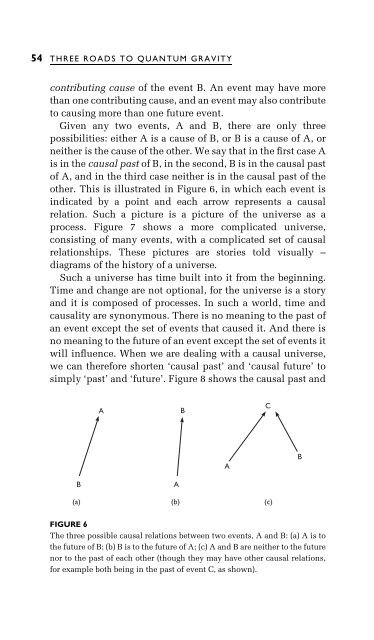Three Roads To Quantum Gravity
Three Roads To Quantum Gravity
Three Roads To Quantum Gravity
Create successful ePaper yourself
Turn your PDF publications into a flip-book with our unique Google optimized e-Paper software.
54 THREE ROADS TO QUANTUM GRAVITY<br />
contributing cause of the event B. An event may have more<br />
than one contributing cause, and an event may also contribute<br />
to causing more than one future event.<br />
Given any two events, A and B, there are only three<br />
possibilities: either A is a cause of B, or B is a cause of A, or<br />
neither is the cause of the other. We say that in the ®rst case A<br />
is in the causal past of B, in the second, B is in the causal past<br />
of A, and in the third case neither is in the causal past of the<br />
other. This is illustrated in Figure 6, in which each event is<br />
indicated by a point and each arrow represents a causal<br />
relation. Such a picture is a picture of the universe as a<br />
process. Figure 7 shows a more complicated universe,<br />
consisting of many events, with a complicated set of causal<br />
relationships. These pictures are stories told visually ±<br />
diagrams of the history of a universe.<br />
Such a universe has time built into it from the beginning.<br />
Time and change are not optional, for the universe is a story<br />
and it is composed of processes. In such a world, time and<br />
causality are synonymous. There is no meaning to the past of<br />
an event except the set of events that caused it. And there is<br />
no meaning to the future of an event except the set of events it<br />
will in¯uence. When we are dealing with a causal universe,<br />
we can therefore shorten `causal past' and `causal future' to<br />
simply `past' and `future'. Figure 8 shows the causal past and<br />
A<br />
B<br />
C<br />
A<br />
B<br />
B<br />
A<br />
(a) (b) (c)<br />
FIGURE 6<br />
The three possible causal relations between two events, A and B: (a) A is to<br />
the future of B; (b) B is to the future of A; (c) A and B are neither to the future<br />
nor to the past of each other (though they may have other causal relations,<br />
for example both being in the past of event C, as shown).



![arXiv:1001.0993v1 [hep-ph] 6 Jan 2010](https://img.yumpu.com/51282177/1/190x245/arxiv10010993v1-hep-ph-6-jan-2010.jpg?quality=85)


![arXiv:1008.3907v2 [astro-ph.CO] 1 Nov 2011](https://img.yumpu.com/48909562/1/190x245/arxiv10083907v2-astro-phco-1-nov-2011.jpg?quality=85)








![arXiv:1002.4928v1 [gr-qc] 26 Feb 2010](https://img.yumpu.com/41209516/1/190x245/arxiv10024928v1-gr-qc-26-feb-2010.jpg?quality=85)
![arXiv:1206.2653v1 [astro-ph.CO] 12 Jun 2012](https://img.yumpu.com/39510078/1/190x245/arxiv12062653v1-astro-phco-12-jun-2012.jpg?quality=85)
